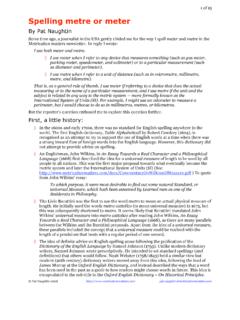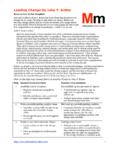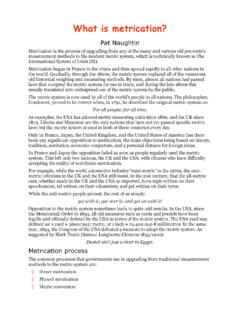Transcription of Cost of non-metrication in the USA
1 cost of non- metrication in the USA Pat Naughtin This is a very complex question as it is really about a number of smaller questions that add up to the overall final costs of not using the metric system by itself. Because of this, I have answered this question using a Question and Answer technique. Question: How much does it cost the USA to be non-metric or to use dual measurements metric and Customary? Answer: Despite the positive experiences of every country, every industry, and every business in the world that has already upgraded to the metric system, this question has not been well researched. To help us to develop our thoughts about the costs of non- metrication , I will include some similar questions before I answer them. I have listed them in alphabetical order. How many businesses have lost orders or contracts because they could not do the job in metric? How many businesses have not even been approached for quotations or estimates because international businesses automatically assume that businesses in the USA cannot do metric work?
2 How many have had to pay a premium for metric parts because they only bought enough for a specific job? How many have made costly mistakes in converting a metric job to old pre-metric measures? How many people have had to be terminated because they refused to work in metric? How much does it cost to find, to employ, and to train their replacements? How much are we, in the USA, prepared to pay to be different to everywhere else in the world? How much does it cost to have someone buying one fastener when they need the other and having to make a second trip to the store to rectify the problem? How much does it cost to retrain school leavers in old measures when they have been taught the metric system at school? How much extra does it cost for duplicating products in both metric and Customary? How much extra does it cost for keeping both the metric and the Customary inventories separate?
3 How much extra does it cost to have stores that have to carry both metric and Customary? How much extra production costs are involved with making products like fasteners in both metric and Customary? As an example of cost savings and opportunities taken see: I collected these questions over several years. Some of these were sent to me personally as editor of the ' metrication matters' newsletter, ( ) and many others I collected from metric email lists especially the USMA email discussion list (See: ~ ). Question: Can we look to other nations to find examples of costs? Answer 1: The Confederation of British Industry was established in 1965 to act as a pressure group promoting the interests of the UK's larger businesses. When the Confederation of British Industry (CBI) surveyed its members about metrication in 1980 after 15 years of British metrication they found that ".
4 The extra cost of continuing to work in dual systems of measuring was around 5 000 million every year." "For companies on which the survey was based, increased production costs were equal to 9% of the companies' gross profit and 14% of their net profit when compared to fully metric CBI companies." To put this into perspective: in 1980 5 000 million was roughly half the cost of the entire UK National Health Service; in today's currency, 5 000 M is equivalent to about 16 000 M ; and the net saving each year from 1980 to 2010 is about 16 000 M M /a plus compounding interest for ever year since 1980. Answer 2: In Canada, architects and engineers openly quote two fee schedules for routine activities such as preparing detail drawings, one for metric, one for imperial. The fee schedule for imperial is typically from 10% to 15% higher, reflecting the extra work involved. From the 1970s, Canadian producers of plywood and gypsum wallboard maintained two production lines - imperial (4ft x 8ft) for their major export market (the USA) and metric (1200 mm x 2400 mm) for the Canadian domestic market.
5 However, as the Canadian metric market is only a small fraction of the huge USA export market, the strategy of maintaining two production lines in two measurement systems proved to be too expensive and had to be abandoned. Only one size is now produced the 1219 mm x 2438 mm (4 feet x 8 feet) sheets. Consequently, for the Canadian metric market, sheets now have to be cut down on each job from the USA size to the metric size, which costs time and energy as well as wasting a little more than 3 % of all sheeting materials in all Canadian buildings. In 2010, because of the downturn in the US market for construction materials, Canadian plywood and gypsum wallboard are now exporting more to the world market, which is wholly metric. So more and more Canadian producers are abandoning the imperial USA market to provide metric products for the rest of the world. The time, energy, and 3 % of materials that was wasted are now saved through the use of international standard metric measurements.
6 Question: Wasn't there a move in the UK to retain the old pre-metric measuring words? Answer: Yes, European Commissioner G nter Verheugen announced on 2007 September 11 that: "not only were there no plans to oblige the United Kingdom to abandon the imperial measure, but also that European legislation would be enacted to guarantee the future use of the imperial unit." To my mind the 'allowing' of old measuring words for the UK by Commissioner, G nter Verheugen, in 2007 was a master move in a single stroke of the pen Commissioner Verheugen put the UK at a major economic disadvantage when compared to the all-metric mainland nations of the European Union. The UK has still to carry the impediment of the enormous cost of multiple millions of measuring words, many of which are undefined, while the mainland of Europe does not even have to consider these costs at all. Question: Has there been any international research on the question of the cost of non- metrication ?
7 Answer: On an international scale, let me quote from the Business Plan of the ISO/TC 12 Quantities, units, symbols, conversion factors. See .. Quantities and units are used in practically all industries in the world. They are used in most schools and in faculties of natural sciences, technology, and medicine in all universities in the world, and also in some other university faculties. Quantities and units are also very much used by governments and in every day life. The economic size of the markets can be estimated to trillions of US dollars per year. It is very difficult to select the total market. However, here is an attempt. If only the market for basic textbooks in physics, chemistry, and technology is considered and it is estimated that one chapter out of say 20 chapters deals explicitly with quantities and units (and the other chapters implicitly) it is found that at least 5 % of this textbook market can be referred to the field of quantities and units.
8 This implies billions and billions of US dollars each year. Then consider the time teachers in science and technology at high schools and universities spend on the subject quantities and units. The fraction (including mathematics) is at least about the same order of magnitude as in textbooks, 5 %, probably more. This implies even higher economic resources than for textbooks. In industry, the time fraction spent on quantities and units is probably less than in education let us say only 1 %, which is a low estimate but the total economic turnover is far bigger in industry than in teaching natural science and technology. Hence industrial activities in this field represents several trillions US dollars each year. If the alternative is considered that there did not exist any International Standards for quantities and units, the costs for national and international trade would further increase with at least one or two powers of ten.
9 An estimate, giving the same order of magnitude, has also been made by the National Institute for Standards and Technology (NIST) in USA. Question: Has anyone done any specific research or written about the costs of not going metric? Answer: As far as I can find out, this is an extremely poorly researched question. I will answer this in three parts. I will refer you to articles by Jos. V. Collins (in 1915), Richard P. Phelps (in 1992), and some thoughts of my own (in 2010): Sub-answer 1 Jos. V. Collins did some work on this question in 1915. He concluded in an article called, "A metrical tragedy", that a 'Total annual loss of $315 000 000' could be attributed per year to non- metrication in the USA at that time. (Note: if you allow for inflation between 1915 and now, then Collin's figure for annual losses becomes $6 800 000 000 per year in 2010). I referred to the Jos. V. Collins article at: Sub-answer 2 This question could also be considered as, "How much money is wasted in teaching old pre-metric measures in schools in the USA?
10 " In an article, "The Case for Metric Conversion Now" (1992, December 9) Richard P. Phelps stated that: 'It (USA education system) teaches two systems of measurement in the schools and, the confusion from learning two systems aside, there is a cost to the time spent in teaching two systems. A full year of mathematics instruction is lost to the duplication of effort.' You can view Richard P. Phelps' article after you register on the Education Weekly database at: In 2004, according to the Department of Education, the Total Expenditures for Education in the USA for elementary and secondary education was $972 000 000 000 (972 billion dollars) and this included all expenditures, federal, state, local, and other. (See: ) Assuming that arithmetic and mathematics classes compose about 1/5 of a school curriculum, then mathematics costs billion dollars each year. And if Phelp's conclusion is correct, that 'A full year of mathematics instruction is lost to the duplication of effort', and (allowing for drop-outs) we assume that the average school life of a student is 12 years, then each year in the USA billion dollars is wasted in teaching old pre-metric measures in schools.







